Cheryl R. Cowtan's Blog, page 5
September 18, 2016
“Master’s orders,” she said. “Open your
“Master’s orders,” she said. “Open your mouth.” http://ow.ly/gmVY304j9Hz #samplesunday #TheFergusShe #indie #ian1 http://ow.ly/i/n80Yd


September 17, 2016
Before “Victor Frankenstein” there was
Before “Victor Frankenstein” there was
‘The Castle of Otranto” (1765) Gothic Writing. http://ow.ly/Hp2z304iZOv http://ow.ly/i/n7Rqg


September 10, 2016
A Blissful Variation of “Female in Love”: Shroud of Roses by Gloria Ferris
One of my joys as a reader is to keep my pulse on the ever-changing female protagonist. Generally, I focus on the strengths of the female within the action and fantasy genres, but for this post, I’ll be looking at Bliss Moonbeam Cornwall, the female protagonist of Gloria Ferris’ Shroud of Roses, a Cornwall and Redfern novel, published by Dundurn Press.
[image error]
Mystery is not my genre of choice, but I’ve read Corpse Flower and Shroud of Roses by Gloria Ferris, and have thoroughly enjoyed both novels because of the outrageous antics the main protagonist, Bliss gets up to. She’s a meddling, sometimes intuitive, self-made detective who won’t listen to orders, especially those delivered by a man in uniform. (I’m not talking the postman here).
I’m no psychologist, but I’d have to say Bliss needs an intervention. Or does she? Perhaps my own gender bias needs the intervention to thoroughly process and examine Bliss to determine whether I’m applying limiting expectations to a female character and her ensuing romance.
Shroud of Roses is a Mystery, but has a sub-genre of Romance. Generally, the romance in a novel fulfills a list of genre tropes, but author, Ferris, is not bound by these common elements. Bliss’ unique characterization is delivered through a number of fun and quirky relationships that do not follow conventions. For this writing, I’m specifically going to focus on her love interest.
[image error]Shroud of Roses begins when a well-decomposed body is found in a locker in the town’s high school. Clues lead to the date of the disappearance, and the main character, Bliss, realizes the murder took place sometime during her high school prom, many years before. In Bliss’ not so humble opinion, this gives her every right to begin her own investigation, even though Police Chief, Neil Redfern, has forbidden her to interfere.
This is interesting characterization, right off the bat. A woman decides she is going to do something and no one, not even the police force can deter her. That takes quite a bit of personal confidence and a pretty complete disregard for authority. Not your typical literary female.
To make Bliss’ disregard for authority even more interesting, Ferris writes in the head of the local police force as the love interest in Bliss’ life. The reader first learns of this relationship though a word puzzle that Ferris uses with humorous effect.
“BN RBBD. ND BG BLND CP. HRY
What? She swore she used official texting acronyms but he [Redfern] wasn’t’ good with missing vowels. Thea [deputy] came in and saw him frowning over the message. “Problem, Chief?”
“Here, can you make out what Cornwall is saying?”
He should have known better.
Thea squinted at the message. “Been robbed. Need big blind cop. Hurry. Or maybe that’s need big blond cop.” She glanced at his hair. “In which case, that would be you, Chief. Sounds like you should step on it.”
Female characters in literature generally are the champions of tradition and if we can go by the “tall, dark and handsome” (unspoken silent) female interest of the past, we can say most female characters are the superior communicators in literature. In Shroud of Roses, when Bliss texts Chief Redfern on her cell phone, she saves time and effort by using her own form of acronyms that generally go over Redfern’s head. Her disregard for clear communication, and the importance of vowels, shows the reader right up front what Bliss thinks of tradition and convention.
The double role this introduction to the relationship plays is to clarify how things stand between the protagonist and the Chief of police. Redfern doesn’t respond to Cornwall’s text. He is the perfect dichotomous partner for Bliss: moral, calm, and intelligent, which makes it very difficult for Bliss to manipulate him.
After Redfern finishes his tasks for the day, he heads to her apartment. While he hammers on the door, Bliss continues to let a cheese puff melt on her tongue, completely ignoring him until her fingers are licked clean, and she’s good and ready to let him in. Bliss clearly shows she is not eager, nor dependent on this relationship. She can take it or leave it. Another strength not usually shown by females in romantic relationships.
So if Bliss doesn’t communicate properly with Redfern, doesn’t respect his authority, and plays a number of games that keeps him at the end of his rope, why are they even together?
The next scene involves some role-play into the “robbery” miscommunication from the text, a Taser, a white lace thong, and a flash freezing of “ta ta’s”. You’ll have to buy the book to read the scene in all of its detail. Suffice to say, the interplay between Redfern and Cornwall is a clever dance with Bliss attempting to drag information from Redfern, and Redfern keeping his moral code in place, while they fulfill each others’ needs.
He deftly pressed a clasp and sixteen pounds of equipment clattered onto the kitchen table.
“What’s this thing on your belt? Did you get a second gun?”
“It’s a Taser. I’m the only one authorized to carry it.”
I had always wanted to shoot a Taser. “Can I hold it?”
“No.”
“I just want to see how it works.”
“No.”
“Just show me…”
“No.” He took off his pants and shirt and covered his belt with them.
I added my robe to the pile. “Wow. You do have a second gun, Officer. I hope you don’t plan to use it on me.” I ran my nails down his chest and watched the muscles contract.
Knowing that’s Bliss’ antics can’t corrupt the strong arm of the law, allows the reader to forgive her, her gender trespasses and enjoy the game. At the end of this scene, Redfern requests a promise of secrecy from Bliss before he reveals a body has been found in the old high school. The fact that Redfern isn’t a total iceberg and occasionally slips Bliss info, keeps the reader engaged in the romance that seems to skirt the edges, but never really dips into “true love”.
[image error]The relationship is so strong, it could easily overshadow the mystery, but the characters refer to each other by their last names, which keeps a distance between them. It is these cooling points that serve to keep the mystery the main genre in this plot.
“I’m a friend of Neil’s. He talks about you. I’m the town coroner.”
“Neil who? Oh. You mean Redfern. What’s he been saying about me?”
I’m not qualified to diagnose, but at this point I believe Bliss is a narcissist.
But she’s a narcissist with a past. The fact that Bliss had been at the same prom as the murder victim means Redfern has to question her. A chief questioning a suspect (especially a wanna-be detective) is a power switch that Bliss won’t participate well in. Through the questioning scene we further understand that Bliss is not your typical female swooning over the alpha male.
Redfern in full uniform can be an intimidating sight – for some people. His hard stare made even innocent folk quake in their shoes. “What’s up with you, Redfern? Got a hot tip?”
“Tell me everything you remember about your graduation night. Begin with your arrival at the high school.”
[image error]Cornwall relates a vague tale of the drunken haze that was her graduation night. Redfern takes out his notebook and pen and Bliss thinks…
Things were about to get serious. I stifled a snort at his cop face. He was so cute.
With these few short lines, Bliss shows her strength of character in the face of intimidation, and takes away Redfern’s power. How many novels have we read where the female protagonist trembles in the shadow of the alpha male?
Another deviation from the romance genre Ferris makes is the female’s desire to marry. While most female protagonists in a novel with an alpha male like Redfern would be plotting marriage and family, Bliss is obsessed with solving the crime (when she isn’t drinking margaritas and shopping for designer boots).
In a scene most women would wish for with their special someone, Redfern drops the “p” word into their conversation.
Redfern looked up… “You need to get over this phobia about gynecologists. What do you propose to do when you get pregnant?”
“Uh, not get pregnant. Anyway, I’ve nothing against female gynecologists. But a man poking around a woman’s nether parts for money is just wrong. I suspect his motives.”
Instead of being excited that her lover has mentioned children, Bliss barrels right over Redfern’s question and sets a relationship decision, all on her own. It’s a “take-it-or-leave-it” declaration that shows a fearlessness in the character.
One of the dangers of creating a fearless character is alienating the reading audience. Ferris solves this problem a couple of ways, particularly by including a relationship issue that would have many women packing their bags.
Though Redfern loves Bliss, he won’t bend regulations for her, and he won’t be manipulated by her. He puts Bliss up on the suspect list, right along with everyone else who was at prom the night the murder happened. So he’s safe, he can handle himself and we can watch her antics without judgement.
Secondly, Redfern keeps a picture of his dead wife on his night table at his cabin. Because of this, Bliss won’t sleep there. Instead of manipulating to get him to put it away, Bliss has the courage to take this head-on, speaking to him with brutal honesty.
“After, what, almost four years, you keep a picture of your deceased wife beside your bed. You can’t honestly wonder why I don’t want to spend the night there.”
“Debbie will always be apart of my life. That doesn’t reflect on my feelings for you.”
“It would have been better had you said Debbie will always be a part of your past. I’m giving you all the space you need, Redfern, but I can’t be your solace while you continue to mourn indefinitely.”
We learn two things about their relationship from this scene. Bliss loves Redfern, but she doesn’t need him.
From the reader’s perspective, any sympathy they might have for the chief is replaced by empathic alignment with Bliss. Would any of us tolerate a picture of the dead wife beside the bed?
He grabbed his coat from the hook. “I’ll talk to you tomorrow.”
The door closed very quietly, and a minute later I heard his vehicle start up and drive away. It broke my heart, thinking of him heading back to his cold cabin. But it was his choice. I ate my cheesecake. Then I ate his.
These excerpt shows us the main character has a heart, but she doesn’t wallow in sentimental emotions. She takes off on more murder solving adventures, showing female readers everywhere that we don’t have to sit around waiting for that next phone call, or any direction from a man.
During one of these jaunts, Bliss gets lost on a country road during a snow storm. Ferris could have used this event to bring in Redfern as the rescuing hero, but she stays true to her character. Bliss knowingly relates that if she calls Redfern, he’d “have the whole force” out looking for her. Instead of an easy rescue, which will no doubt come with a “lecture” from Redfern, Bliss opts to leave her car and walk through the dark in deep snow to find help.
Scene after scene, in the relationship between Redfern and Bliss, Ferris does what the reader does not expect. With her strong female protagonist out front and centre, this author crashes through the romance conventions, leaving the reader in awe of Miss Moonbeam.
Down to earth, downright rude, oppositional to authority, but forgiven by the reader because her barbs are delivered with a dash of hilarity, Bliss keeps readers laughing out loud, as she attempts to solve the mystery. But more importantly, at least to me, Bliss moves us out of the traditional tropes of the romantically involved female character to give readers a new concept of romance, and an ever-widening interpretation of “female-in-love”.


How to Design an eBook Cover that Hooks Readers
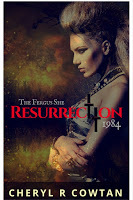 Readability is affected by three things:
Readability is affected by three things:placement of elementsresolution of imagesize of imagePlacement of Elements
Your design is going to be made up of some or all of the following:
background colour, texture or imagelayered symbol or other imagetitle textseries textauthor textdescription textToo many elements can make for crowded design, which is a "no, no", but if you search cover designs online, you'll find some that incorporate all of the above six items well. Why would you? Well Amazon will not allow text in the "title" section of your book posting that is not on your cover. Think about that in terms of targeting keywords potential readers may be searching.
According to DigitalPublishing101's article The importance of ebook covers, an e-book cover has a different job to do than a print cover. Therefore, e-book design should be more impactful as it has a stronger promotional job to do, so should carry more clues to the book's content.
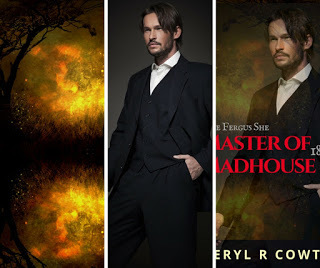 Decide on the mood or atmosphere of your book. Find images at a stock image site that will fulfill the background of that emotional feeling you are trying to impart to the reader. Decide what image would best express what your story is about. Find an image that matches up with your story and will look good (contrast) on the background.Find a font that is readable at thumbnail sizes and that reflects your genre and your story. Find another font that doesn't compete with the first one, and that shows your name clearly. Remember this font will be part of your brand as an author and you might want to use the same font again on other books.Open an image software program that allows layers. I used pixlr. Use the magic wand, the eraser and opacity settings to lay the two images on each other without looking blocky or placed.Open an image software like canstock that offers book cover templates and upload all images and fonts. Design your book. Bownload all file choices (JPG, PNG, PDF etc).www.canstock.com for stock imageswww.pixlr.com for cutting out image backgrounds, and layering imageswww.canva.com for templates of book coverswww.fontsquirrel.com for fonts
Decide on the mood or atmosphere of your book. Find images at a stock image site that will fulfill the background of that emotional feeling you are trying to impart to the reader. Decide what image would best express what your story is about. Find an image that matches up with your story and will look good (contrast) on the background.Find a font that is readable at thumbnail sizes and that reflects your genre and your story. Find another font that doesn't compete with the first one, and that shows your name clearly. Remember this font will be part of your brand as an author and you might want to use the same font again on other books.Open an image software program that allows layers. I used pixlr. Use the magic wand, the eraser and opacity settings to lay the two images on each other without looking blocky or placed.Open an image software like canstock that offers book cover templates and upload all images and fonts. Design your book. Bownload all file choices (JPG, PNG, PDF etc).www.canstock.com for stock imageswww.pixlr.com for cutting out image backgrounds, and layering imageswww.canva.com for templates of book coverswww.fontsquirrel.com for fontsResolution of Image
Resolution refers to the clarity of an image, which is affected by size, pixels and contrast. Digital images are made up of pixels which are small areas of illumination on a screen. Generally, 300 DPI or pixels (dots) per inch is used for print images, and 96 DPI is used for digital images.
Test your book cover at different sizes. Make sure the file size does not go over distributor's guidelines. According to DigitalPublisher101, Amazon has a cover file size limit of 5 MB.
Size of image
E-book covers are shown in different sizes on reading devices and distributor sites. This makes It difficult to ensure a book cover is going to work on all new and older devices, so you really need to do your research and understand the requirements of each distributor (Amazon, ibook etc).
The difference between a print book cover's size and a digital book cover thumbnail is an exercise in math, and one "The Book Designer" has already tackled. According to the article, "Print and e-Book Covers: A Matter of Resolution", e-books have 1/17 of the image information needed for print covers. Author Joel Friedlander suggests remembering this when designing.
An e-book cover needs to be visible at a size as small as 2 x 3 cm in an Amazon thumbnail.
It's important to follow all of the technical rules, however, we don't want to get bogged down in technicalities, because book-buying can also be impulsive, based on emotional responses to a cover, which is created through image, font, atmospheric and genre conventions in the design.
Designing a cover can take a long time, and what you end up with might not be what you started with. See my example below. "The Fergus She" cover went through a number of changes before I got the look and layout I liked and that I felt matched the genre.

June 26, 2016
How to write the best pitch for twitter pitch contests
Currently I'm participating in PitchSlam, and I have found this pitching competition offers a new benefit--critique by professionals. The process works like this.
Pitch 35 wordsReceive feedback for improvementSubmit first 250 wordsReceive feedback for improvementSubmit revised 35 word pitch and revised 250 wordsWhat I found is the reviewers caught some pretty obvious mistakes in my work that I did not catch after multiple reads. And once I followed the suggestions, the improvement of my pitch and first 250 is encouraging. Compare the results yourself.
My first 35 word pitch:
Name: Cheryl R Cowtan
Genre: Adult / Dark Fantasy
Title: The Precious Quest
Word Count: 90,000
Song: Ayreon - River of Time http://www.youtube.com/watch?v=2XAPosjkbfQ
Pitch: When the Firslain betray the goddess, and breed abominations to replace the virtuous, Laywren, Queen of the Horde, swears to defeat the deceivers, cleanse the unnatural, and restore the goddess, before their world is lost.The pitch feedback I received:
Your pitch gives a lot of details, but about things and people that are unique to your world, which is disorienting. The pitch would work if the reader was as familiar with your world as you are, but we have no idea what Firslain, the virtuous, breeding abominations, the Horde, the deceiver or the unnatural are. As such, we can't grasp what's going on in the story or why. Paint a picture of the central plot in a way that someone who has no idea what your book is about can understand.
I submitted my MS first 250 words:Nethaz, the giant warrior dropped to his knees. The impact of his weight rumbled the rain-starved ground beneath my feet. I raised my bow, scanning the forest at his back and the battlefield at his side. But no shadows leapt between the tree trunks below the twisting, yellow leaves. The bodies of the dying warriors lay still in the red dust, sprawled out across the distance between the giant and the tip of my arrow. Nethaz’s powerful hands released his axe and shield, and the clang of his weapon’s fall echoed across the field, ringing into silence. His head dropped to his chest, and his black hair parted revealing the back of his neck. An axe wielder does not bear his neck, not on the field of battle. “What ails you?” I called out. He did not answer, but rocked on his knees, his long hair swinging around his face. I listened in disbelief, as a low keening moan escaped his twisted mouth. My heart hardened against him, for his tears were staining our hard-won victory. Turning my bow his way, I narrowed my eyes against the drying wind. As I made my decision, the blood rushed to my ears, and the sound of Nethaz’s shuddering breaths sharpened. “What do you plan to do, Laywren?” Dorn’s steady voice rolled across my tense back, as he walked up from behind me. I did not turn. “Nethaz regrets fighting for the Horde,” I answered, drawing back the arrow until the bowline sung.
The 250 words Feedback I Received In the first line you tell us Nethaz is a giant warrior. You've shown warrior, why not show his size by the way he moves or by describing his girth. You've got a start on that in the way the ground rumbles. No need to tell in the first line. Also you use 'bear' his neck, when the correct homophone would be 'bare' as in made naked by brushing away the hair/clothing. There is a missing comma after 'parted' and before 'revealing.' Watch words like 'up, down' off, out' and other directionals as often they can be cut. This piece did raise my curiosity about what would happen next. And despite starting in the middle of action, I was able to follow what was happening and even want to see more. Working from the feedback, I revised both the pitch and the 250 words. Here are the results: Name: Cheryl R Cowtan Genre: Adult / Dark Fantasy Title: The Precious Quest Word Count: 90,000
Song: Ayreon - River of Time http://www.youtube.com/watch?v=2XAPosjkbfQ
35 Word Pitch: When the goddess’ sons betray their mother and corrupt the world with evil, Laywren, Queen of the Horde, sacrifices her pride, her lover, and her rule to defy temptation, defeat chaos, and restore the goddess.
250 Words: Nethaz dropped to his knees, the impact rumbling the rain-starved ground beneath my sandals. I raised my bow, scanning the forest at his back. But only the twisting, yellow leaves moved among the trees. Between the giant and the tip of my arrow, the bodies of the fallen warriors lay still in the red dust. Nethaz released his over sized axe and shield, and the clang of his weapon’s fall echoed across the field, ringing into silence. His chin dropped to his massive chest, and his black hair parted, revealing the back of his neck. An axe wielder does not bare his neck, not on the field of battle. “What ails you?” I called out. He did not answer, but rocked on his knees, his long hair swinging around his face. I listened in disbelief, as a low keening moan escaped his twisted mouth. My heart hardened against him, for his tears were staining our hard-won victory and were insulting to the goddess. Turning my bow his way, I squinted against the drying winds. “What is wrong, Laywren?” Dorn asked, as he walked up behind me. “Nethaz regrets fighting for the Horde,” I answered, drawing back the arrow until the bowline sung. Sobs ripped out of the warrior’s depths, and my face burned with his shame. “Will you slaughter a warrior who has just fought like a god for your glory?” I could feel Dorn’s amber eyes searching for mine. “There is no glory in weakness,” I replied, steadying my aim.
I feel empowered by the suggestions provided on PitchSlam. It's one thing to have that emotionally satisfying feedback of "awesome" or "good", but it's quite another to receive actionable responses to my work. That's where the true value lies, in the feedback that guides improvement.
What do you think? Improved?
Where can you see changes still being needed?
If you are a writer, consider all of the Pitch competitions, but especially PitchSlam for the value you will get through feedback on your work.
You can find me on Twitter at NspiredMe2Write, where I will be sharing more tips from my author's journey.
June 15, 2016
How to Quote your Novel and Increase Book Sales
People love quotes from novels because they reflect, in better words than most of us can come up with, life experiences, feelings and views on important issues. Quotes also have the ability to affect us on a sentimental level, reminding us of a time we may have first experienced the novel being quoted.
The best lines are timeless.

How to Choose Quotes from your NovelFor writers, quoted lines from a novel can accomplish a number of things, but the most important goal for quoting your book is to create a curiosity or desire in the reader to read more. Consider this goal when searching for good lines.
Your quote also functions as a sample of your writing. The quote you choose can do any of the following:Show the author's styleShow the quality of writingExpress the genre through conventionsEngage readers with a characterHook readers into wanting to know moreThe ashes could have been the frayed remnants of my life, charred and aimlessly drifting from the impact of Scarlett’s resurrection. I could see no way to tear myself free.
If you aren't sure about the lines you should quote from your book, you can also ask your beta or buying readers, or look for those "beautiful" comments from your editor. Post a request on FB or wherever you connect with readers. Ask them to share their favourite lines.
How to Format a Quote from your NovelWhen possible, format your quote to stand out. Change the font, the indent, the size, the colour, or even better, put it on an image. Pictures catch attention, express emotion and portray genre. As well, viewers process images much faster than text.
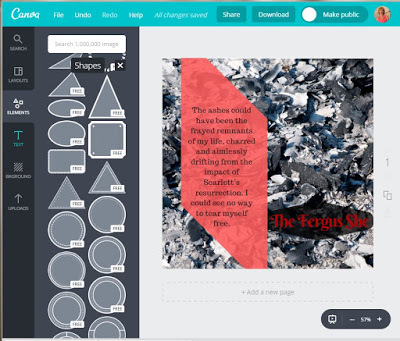 There are many free graphic design tools available to you on the web. One I use is Canva.com. It offers the ability to upload your own photos and images, which you can also get from Flickr and from Google searching. Make sure you select only materials that are licensed for reuse and modification. For example: I got the ashes image from Flickr, where Otto Phokus provided limited rights for its use.
There are many free graphic design tools available to you on the web. One I use is Canva.com. It offers the ability to upload your own photos and images, which you can also get from Flickr and from Google searching. Make sure you select only materials that are licensed for reuse and modification. For example: I got the ashes image from Flickr, where Otto Phokus provided limited rights for its use. One of the most important things to remember when using these great graphic tools is to stick with your novel's promise in the design. That means, if your novel is a romance and your cover is already branded with colours and images, you'll want to continue that brand and promise in all of your graphic promotions.
Choose your fonts, colour, image and quote to advertise the promise of your novel. My "in progress' novel, The Fergus She is an urban fantasy, which promises the protagonist will suffer and possibly fail. I express this promise of a character's suffering through my choice of quote. The graphic also promises dark forces, Gothic elements and some vampire lit (colour, shapes and font style). The choice of ashes for the background provide a visual for the quote, but also matches the theme of the novel through symbolism (death, rebirth through fire).
This article is an excerpt from "Technology #WritingTips for Writers" available soon. To get your free copy, sign up at http://www.cherylcowtan.com. Where to Post Quotes from your Novel Many author do not use this valuable resource to its full advantage. Imagine, you have thousands of words you penned and own the rights to. You can quote your own work indefinitely without any copyright concerns, because you own it.
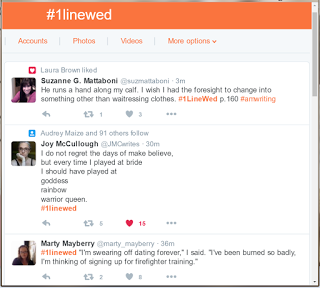 Quote lists:List of Powerful Literary Quotes Goodreads is the cornucopia of book Quotes
Quote lists:List of Powerful Literary Quotes Goodreads is the cornucopia of book QuotesSocial Media:Twitter #hashtags include #1lineWed #bestline #novelline #bookline #amreading #quote #bookquote #quoteoftheday and moreFacebook, post on your author's page and in your personal FB. Post on groups when the self-promote day arrivesCreate a Pinterest board and start sharing and collecting. Add your quotes to this board.Post on TumblrInternet Communication:Quote lines on your Web siteImbed them in your newsletterAdd one to your email signatureCreate audio clips of you reading a line or passage from your text
Author Quotes on Reading:
Yes, there are even lists of quotes from authors on reading. Some of them are excellent, like "A book is the only friend who, when it turns its back on you, is still there for you."
Think up a clever quote about reading that you believe in. Then start quoting yourself online. It will get picked up.
Write a Few Quotable Lines into Your Novel
If you're writing hasn't revealed any quotable lines to this point, or perhaps you'd like to really focus on how to create a timeless quote for your readers to share, scan through your novel and find a place you can put one in. That said, obviously you don't want the line to seem contrived or awkward, so you'll have to put a lot of thought into it.
This article is an excerpt from "Technology #WritingTips for Writers" available soon. To get your free copy, sign up at http://www.cherylcowtan.com.
June 6, 2016
How to Use MS OneNote to Organize Writing Research and Novel Outlines for Writers
Let’s Get Organized
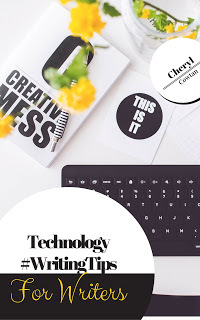 Writers take a gazillion notes. I don’t have to tell you this, because you know all about it. You also know how difficult it is to organize notes, search through paper notes, and sometimes even find all the notes you've written.
Writers take a gazillion notes. I don’t have to tell you this, because you know all about it. You also know how difficult it is to organize notes, search through paper notes, and sometimes even find all the notes you've written. In this day and age, going digital is the best way to keep track of your notes. If organized properly, digital notes are sortable, searchable, editable, accessible from anywhere, and light as a feather to carry around.
In this blog, I'm going to show you how to be note-efficient.
____________________________________________________
The following is an excerpt from "Technology #WritingTips for Writers". First 100 subscribers at http://www.cherylcowtan.com get a free copy at book launch._____________________________________________________
The first step in getting note-efficient is finding the right software. For writers, finding a software that will meet all of our needs is like trying to pick a toothpick from a sea urchin... under 10 feet of water... in shark infested...
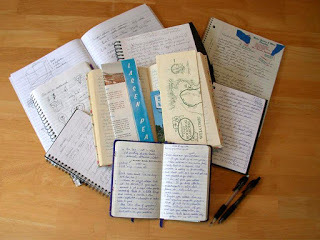 Okay, okay, bad simile. But seriously, finding the right software for our writing needs can be painful and expensive. So let's stop wasting time and money and get organized.
Okay, okay, bad simile. But seriously, finding the right software for our writing needs can be painful and expensive. So let's stop wasting time and money and get organized. In the name of efficiency (which leads to more time for writing), we have to make a choice. I say to you, today, we will be together in the cloud! Here's how.
 Benefits of Microsoft OneNote After trying a number of software options for organizing my writing research and outlining my novels, I was getting discouraged. Then I tried OneNote! For me, the app has been such a revolutionary organizer, I'm writing a book about it. Here's why I love it.
Benefits of Microsoft OneNote After trying a number of software options for organizing my writing research and outlining my novels, I was getting discouraged. Then I tried OneNote! For me, the app has been such a revolutionary organizer, I'm writing a book about it. Here's why I love it.It has an easy-to-use interface (no headaches, self-esteem damage, confusion, trying-and-giving-up in despair, AND no need to take a course to learn how to use it).It's free. It will import your material from other software like EverNote, Excel, Microsoft, the web etc.It has a deep hierarchy (levels of storage), which allows you to keep filing and splitting off that filing and filing some more. (No deleting, recreating, and duplicating unnecessarily). It's accessible from multiple platforms and devices (from your phone, desktop, laptop etc.) because it stores on the cloud. How TO Download OneNote If you have a Microsoft Office license, OneNote is in your programs. Click your "start" menu on the bottom left of your Windows screen and search OneNote.If you are using a mobile device, OneNote is available free through your app store.If you have a WindowsLive, Hotmail, or Outlook e-Mail account, you can download OneNote free from Microsoft.
SkillBuilder!
Download now by going to http://www.onenote.com/DownloadFollow the instructions.
OneNote Organization
OneNote is organized with the following hierarchy:

The Notebook is at the top, followed by sections, then followed by section pages. SkillBuilder!Open NotebookSelect "New"Type in the Notebook Name. I used the name of my novel, The Fergus She 1984 The Scarlett Resurrection. At this point, you can also choose to share your Notebook by inviting people. If you're not sure, just select "Not Now".
_____________________________________________________
 The first 100 readers to sign up to my mailing list at my Website will receive a free copy of my "Technical #WritingTips Book for Authors" book, when it launches. _____________________________________________________
The first 100 readers to sign up to my mailing list at my Website will receive a free copy of my "Technical #WritingTips Book for Authors" book, when it launches. _____________________________________________________Once you are in the Notebook, you can start building your sections and pages.

You might call your sections Character, Plot, Research, Marketing Plan, etc. Under each section, you will create pages. Under Character, you could have the character profile of the main characters in your novel as each individual page. Under Plot, you could have pages outlining your three act structure, or your chapters, or whatever order you like to plan your writing in.
How TO Make Your OneNote Notes AccessibleThis is where you have to store your notes on the cloud so you can add and use your information no matter where you are or which device you're using. SkillBuilder!Select “File”, and then “Settings”, and then “Properties”Set your OneNote up for “Cloud” sharing if you are going to access it from more than one device.
How TO Put Your Notes in OneNote One of the best features about OneNote (for me) is the ability to imbed images, Excel and MS Word docs into the OneNote application. Now instead of the multitude of files I have on my computer, it will all be well organized in my OneNote Notebook.
 SkillBuilder!Go to the page you want to insert a file into.Select "insert" for MS Excel or "attach" for MS Word.Your other option is "file printout" for showing an image or doc file.
SkillBuilder!Go to the page you want to insert a file into.Select "insert" for MS Excel or "attach" for MS Word.Your other option is "file printout" for showing an image or doc file. What Happens if I edit a file after I put it in OneNote?This is a great question. Once a file is in OneNote, you can edit the original and OneNote will make the update for you. That's the best thing since moleskin notebooks, eh?
What Happens if I edit a file after I put it in OneNote?This is a great question. Once a file is in OneNote, you can edit the original and OneNote will make the update for you. That's the best thing since moleskin notebooks, eh? SkillBuilder!Run your mouse over the top left of the document showing on your NoteBook page until you see the word "edit". Click it.Your original file will pop up on the screen, as you can see above.Make a change. I added a colour to row 5 column 1. Click "save" in your original file. The change will then appear in your NoteBook version.
SkillBuilder!Run your mouse over the top left of the document showing on your NoteBook page until you see the word "edit". Click it.Your original file will pop up on the screen, as you can see above.Make a change. I added a colour to row 5 column 1. Click "save" in your original file. The change will then appear in your NoteBook version.As a fellow writer, I really hope you find OneNote to be as functional and easy as I did. If you have any trouble, click the "help" link on the taskbar or do a search in Google.
If you liked the layout and structure of this blog, you'll love my more-in-depth novels on using technology to help you be a better writer.
I am currently writing three non-fictions on using technology for writing, publishing and marketing.
Want to learn more? Click here to sign up for my mailing list. If you make it into the first 100 readers to sign up, you will receive a free copy of Technical #WritingTips for Authors, when it launches. If you don't make it into the first 100, I'll let you know when the book is for sale.

May 15, 2016
Mail Order Prostitutes in the Old West: Juliet James’ “Emily”
Look at the cover. Would you expect this book to be about a “mail order bride” prostitute ring? Well it is, and it isn’t. It’s about a family of brothers and the brides who arrive to their small Montana town, but beneath this light story a darker story is hinted at.
I should not have been surprised, because in the beginning of this novel, the author started out with a promise of male brutality. The main character, Emily, finds herself witness to a ruthless murder which leads her to run away, the murderer in pursuit.
Yet this scene is quickly left behind as she leaps upon a train and is swept up into her next adventure – true love in the frontier. Emily only reflects briefly on the murder scene, which made me think it was an inciting incident, a clever plot event to get her where she needed to be, and then left behind with her old life.
It was also easy to miss this original promise because of the intrusive narrator. This style of writing takes us into another example of male brutality part-way into the story, but it is so glossed over by “telling”, we don’t really experience it at the level we should.
“‘Good girl,’ he told her, as he began to take down his britches. ‘Now this won’t hurt a bit, and you might even like it…and never speak another word about it…’
Emily was terrified, of course, and frozen from the fear too. She thought of trying to cry out, but even as she had the thought of it, the door flew open and another man set upon Slim Jim, knocking him to the floor…”
The characterization in this novel would be much stronger if James freed the narration from that of “telling” to “showing”. Instead of explaining to the reader Emily was terrified, the author could describe the psychological and social-emotional reactions the character experiences.
Emily cowered in the corner, pressing a plea for mercy out of her trembling lips. Her words hung in the air between them, ignored. A sense of dread crept up the naked skin at the back of her knees, locking her legs in place, as she braced for his attack.
Descriptive reactions serve to draw the reader into feeling the horror of the character instead of just hearing about it.
“Don’t tell me the moon is shining; show me the glint of light on broken glass.”
― Anton Chekhov
Now the telling did allow the author to cram in a lot of material and story time into a short book. As well, if an author wants to discuss uncomfortable material but does not want to dwell on it, this is an effective way to holds the reader at arm’s length.
[image error]
Though most of the dark deeds were glossed over, I personally took a time out to consider the chilling reality of the concept of a fake mail-order-bride operation. Probably because of my history of working in social work, specifically in violence against women.
[image error]
Imagine young girls raised in the 1800s, arriving by train at small Western outposts
that are barely civilized. These girls arrive with little money, no contacts, nothing but hope, and a letter from a potential husband. They arrive thinking they’re going to be married to a complete stranger (which is scary enough). Soon they find out the man who met them at the station will rape them and put them into service in the local saloon. OR rape them (these girls will likely be virgins based on the time period) and then allow them to meet their husband under a pact of secrecy bought through threats.
That premise is terrifying and these books (there is a series) could have provided a much deeper exploration into the dark side of mail order “briding”. But not with the author’s style which is to narrate the story on a surface level, rarely dipping down into the emotional experience that love, fear, abandonment and crime can instill. However, the author obviously did not want the brutality to be the point of her novel, and in that she succeeded.
Author, James has a talent for pacing and that’s what held my interest, that and the characters, who are likable. The plot events chop along at a good rate, and I found myself turning the page into each new chapter to see what was coming. However, I could also put the book down if I had other things to do because the connection to the character’s experiences was not as strong as it could be.
As a light, quick read with the whisper of a deeper than your average Western romance plot, “Emily” and the other books in this series will keep you entertained through a rainy weekend, and will satisfy readers looking for a light romance.
March 17, 2016
First Steps in the Scrivener Waltz
I finally did it. I purchased Scrivener. Now I have to hold onto my self-worth as I try to wrap my brain around the interface. I keep telling myself, so many experts can't be wrong, right? Surely, when I've mastered this program, I'll come out on top. On top meaning I will have a tool that will give me more functionality, save me more time, and overall, make me a more organized and efficient writer.
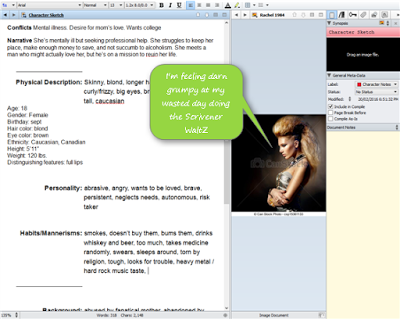 Currently, I'm doing pretty good with a combination of MS Word and Excel, so this baby better be awesome to convince me to convert for long term.
Currently, I'm doing pretty good with a combination of MS Word and Excel, so this baby better be awesome to convince me to convert for long term. So I start to learn it like I learn all things - jumping in with both feet. Click, click, click, click.... cli...
That didn't work.
So basically, I've purchased the Scrivener software that experts are saying is functionally amazing, but its user interface is so non-intuitive, I can't figure it out, and I used be an Internet Business Consultant. Surely my skills aren't that rusty.
A few searches and I discover most of the experts claiming Scrivener works great, have paid for this course LearnScrivenerFast, which seems to consist of concise engaging lessons. Problem solved right?
Wrong! I paid $50 for Scrivener, and this awesome course is another $300. So, basically, I just purchased a license to a software product that people have had to create courses on, so users can figure out how to use it. That doesn't sit right with me.
Second reason not to part with my Canadian loonies has something to do with the Yukon Gold Rush. In the late 1890s, about 100,000 hopeful prospectors hiked into the Canadian Yukon hoping to find gold. Now I ask, was it more fruitful to be a miner during the gold rush or did selling pickaxes to all the men with gold fever turn a better profit? You got it. Owning the mercantile was the way to make the most money and to come out a winner.
So, I'm trying to limit my spending. Each dollar I spend learning how to be a better writer is going to come out of my profits when I am a better writer. Basically, I'm climbing the Yukon trail without the pickaxe!
Still trust me?
So, after an entire four hours spent struggling with the Scrivener interface (1990's interface I might add), I wouldn't personally suggest purchasing it. But if you did, like me, here is what I feel are the very first steps to take.
Step 1: Start with an established Novel Outline TemplateGenerally, step 1 should refer you to the 340 page PDF document Scrivener offers, however, I think the beginning of this sentence already explains why you shouldn't start there, if you're in a hurry.
The Book Ninja offers non-fiction templates for $10, and many sites offer free templates. Too many. So this might take some time.
Start with Google. Search for the keywords "Free Scrivener Novel Outline Fiction OR Non-Fiction". Then start weeding through the results. I found Caroline Norrington's Fiction outline to be quite detailed.
Once you have downloaded the zip file, you will need to follow these instructions.
Your computer should unzip the file if you click the folder. Save the files in a computer folder you name "Scrivener templates"Open your Scrivener program and select "file" and then "open" Find your .scrivtemplate file where you saved itStep 2: Open the InspectorOpening the inspector in Scrivener was like putting an addition on the house. Click the "view" tab in the top row of navigation in Scrivener.Select "layout" from the drop down menu.Click the box beside "inspector" to open it in the right of your screen. A shortcut option is to click the little blue circle in the top right of the Scrivener screen.Interface Rant: There are too many ways to accomplish actions in this software.
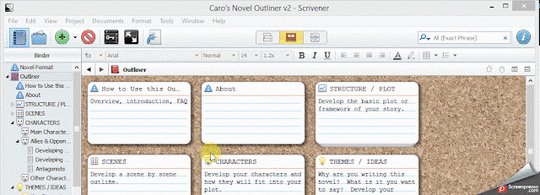
The inspector will show you:SynopsisNotes (notes attached to binder items (chapters) or general notes attached to the entire manuscript, or images you drag and drop there).References (links to document or global/project references)Keywords (keywords associated with your selected document)Meta-data (label and status, modified and created date).Snapshots (like file versions in case you want to revert to an earlier draft)FootnotesCommentsStep 3: Click EverythingMove your mouse around Scrivener before you get your manuscript in there, and just start clicking and following the dropdown boxes and see what it does.
Yes, you'll find a multitude of buttons that add items to your binder. The good news is, you'll learn to highlight and drag those items to your trash bin. I did this many times.
Now that you've established you haven't learned anything, but you have reduced your fear of clicking buttons, you are now ready to import your manuscript.
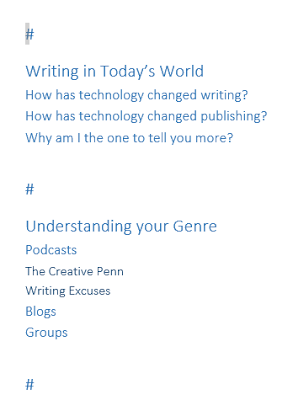 Step 4: Importing MS Word into ScrivenerHells Bells! It took me about two more hours to find a semi-acceptable way to import my established MS Word manuscript into Scrivener using the "import and split" feature.
Step 4: Importing MS Word into ScrivenerHells Bells! It took me about two more hours to find a semi-acceptable way to import my established MS Word manuscript into Scrivener using the "import and split" feature.What I was hoping for is that Scrivener would recognize Heading 1 and Heading 2 and Heading 3 commands of my MS Word doc and then separate accordingly into chapter folders in the binder. No such luck, so far. If anyone knows of another way to accomplish this, please let me know.
Type a key symbol of your choice into your manuscript to indicate where Scrivener should split your text into sections upon import. I used this key # - see image to the right.Save your MS.Watch the rest in the visual below, and then return to the following steps for clarification
In Scrivener, click "file" and then select "import" and then select "import and split" (see visual example below).A pop-up will ask for more details. Select your MS file, then type in the key you used to identify the splits (#).Once you've imported, you will see the splits in the binder section of Scrivener. In my example above, I have chapters and sub-titles. My next step is to place my curser in front of each sub-title in Scrivener and click CNTRL + K This will split off another section for me. You can't see me clicking the button combination, but you will see me placing my cursor in front of "How has technology changed Writing" etc.Last step is to convert the binder items into chapter folders or sections.
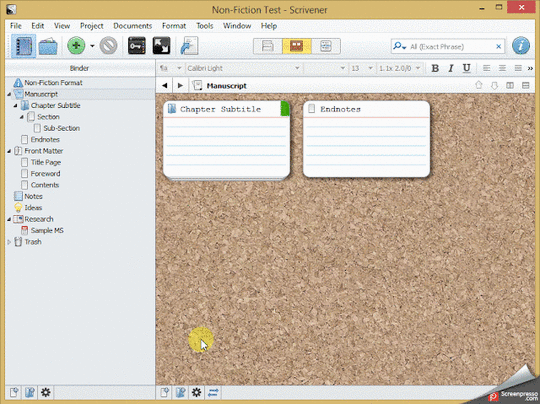
If you did this step differently, how did you do it?
Is there an easier way? I'd love to hear it.
With your help, maybe you'll save me from wasting another day I'll never get back on the Scrivener Waltz.
Yikes!
How to Edit Overused Words in Your Novel Manuscript
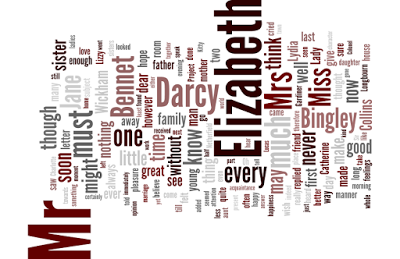 Wordle for Jane Austen's Pride and Prejudice
Wordle for Jane Austen's Pride and PrejudiceWordle is probably the easiest tool for finding overused words in your novel, because you just paste your entire manuscript into Wordle and wait for the results.
Wordle creates an image of the most often used words in the text, increasing the font size of a word based on how many times it was used. The Pride and Prejudice Wordle is interesting as a comment on societal manners at the time it was written by Jane Austen (Mr, Miss, Mrs).
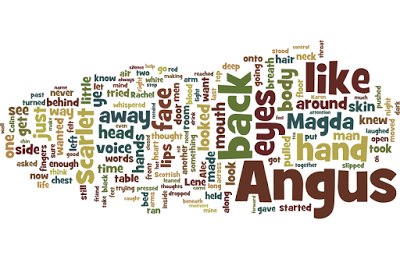 Wordle will increase the font of words
Wordle will increase the font of wordsused more often in your Manuscript.The Wordle above is from my current manuscript The Fergus She. If you notice, the word "Angus" is in the largest font.
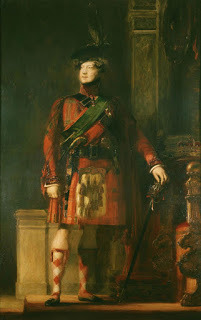 Angus is hotter than this!The visual is telling me I used "Angus" more than any other word, which is good because he's the hot highlander my protagonist, Rachel, is lusting for. Where is Rachel's name? you might ask.
The Fergus She
is written in first person POV, from the point of view of Rachel, so you won't see her name in large font.
Angus is hotter than this!The visual is telling me I used "Angus" more than any other word, which is good because he's the hot highlander my protagonist, Rachel, is lusting for. Where is Rachel's name? you might ask.
The Fergus She
is written in first person POV, from the point of view of Rachel, so you won't see her name in large font. In the Wordle graphic, the next font size (after Angus) are words like "back", "eyes" and "hands". I don't think these are important words to my story or my theme, so basically, I need to cut them down, and because these are mostly body part words, I need to go through my manuscript and really work on body language descriptions to remove redundancy.
I open my manuscript in MS Word, and I use the "find" feature to highlight all of the instances of the word "back" in my text. The shocker? The word "back" is quite versatile, so versatile, in fact, I used it over 125 times.
I read each instance of using "back" in order to understand the context in which I used it, and then I decide to either change the word or to leave it.
Below are some of the ways I got rid of the word "back". She walked back to the couch > returnedA chill shivered down my back > spineI looked back at him > (remove)She took a step back > awayHe leaned back against the pillows > (remove)
Once I was satisfied with those changes, I searched for the word "eyes" in my manuscript. This one was harder to edit. I had to do some deep thinking about body movement that could relay the same emotions I wanted to show with "eyes".
After reading a few examples of my word use, I realized I had to get help. I found it in some great, free resources online in 30 synonyms for look, descriptions of eyes, and descriptive words for eye-catching (a little off topic but definitely helpful).
Here are some changes I made:
I lifted my eyes to the Magnolia’s grey trunk > I considered the Magnolia...... her eyes lit on the landlord’s red Firebird convertible parked in the lane. > ...a slow smile spread on her face as she glanced at the red Firebird convertible parked in the lane.I couldn’t resist watching as Scarlett stopped on the sidewalk and ran her eyes over the front windows of the house. > ...stopped on the sidewalk and spied on the house.
Wordle is free to use and only takes a few minutes. I'd love to see your Wordle and hear how it informed your manuscript editing.
In a future blog, I'll explain a more complicated way to edit overused words using Macros in MS Word.
 Can you guess this famous manuscript from the Wordle above?
Can you guess this famous manuscript from the Wordle above?





